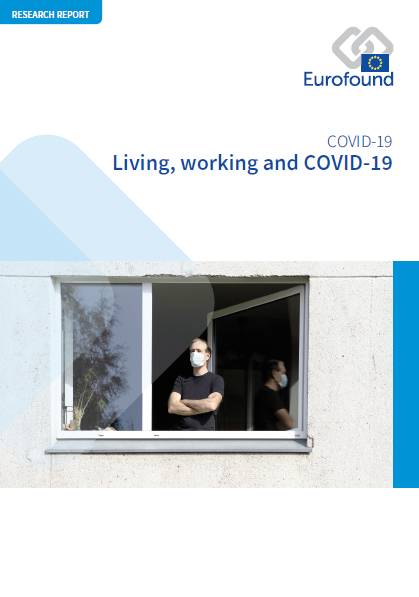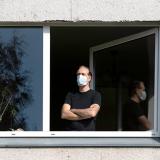
This report presents the findings of the Living, working and COVID-19 e-survey, carried out by Eurofound to capture the far-reaching implications of the pandemic for the way people live and work across Europe. The survey was fielded online, among respondents who were reached via Eurofound’s stakeholders and social media advertising. Two rounds of the e-survey have been carried out to date: one in April, when most Member States were in lockdown, and one in July, when society and economies were slowly re-opening.
The findings of the e-survey from the first round reflected widespread emotional distress, financial concern and low levels of trust in institutions. Levels of concern abated somewhat in the second round, particularly among groups of respondents who were benefiting from support measures implemented during the pandemic. At the same time, the results underline stark differences between countries and between socioeconomic groups that point to growing inequalities.
The results confirm the upsurge in teleworking across all countries during the COVID-19 pandemic that has been documented elsewhere, and the report explores what this means for work–life balance and elements of job quality.
Key findings
Po zrušení obmedzenia pohybu ľudia v celej Európe zaznamenali vo všeobecnosti zlepšenie svojej situácie, pričom v júli sa v porovnaní s aprílom zaznamenalo zvýšenie počtu odpracovaných hodín a nižšia miera neistoty zamestnania. Medzi určitými skupinami v EÚ však vznikli značné nerovnosti.
Napriek tomu, že v mnohých krajinách boli rýchlo zavedené opatrenia na podporu osôb, ktoré prišli o pracovné miesto, viac ako polovici nezamestnaných respondentov nebola od vypuknutia pandémie COVID-19 poskytnutá žiadna oficiálna finančná pomoc, v dôsledku čoho sa mnohí museli vo veľkej miere spoliehať na neformálnu podporu. Počet osôb, ktoré uviedli, že mali problém vystačiť si s príjmami, bol najvyšší v prípade nezamestnaných respondentov a v júli bol ich počet v porovnaní s osobami v domácnostiach pracujúcich dvojnásobný.
Jednou zo skupín, ktoré v dôsledku obmedzenia pohybu stratili najviac, boli mladí ľudia. Spolu s tými, ktorí prišli o prácu, uvádzajú najnižšiu úroveň kvality životných podmienok, a to aj napriek tomu, že situácia sa od začiatku pandémie mierne zlepšila. Aj keď sa miera spokojnosti so životom a optimizmu od apríla zvýšila, mladí ľudia sa naďalej cítia zo spoločnosti vylúčení a sú najviac vystavení riziku depresie, čo ukazuje, ako ich obmedzenie pohybu väčšmi ovplyvňuje.
Pandémia tiež naďalej neúmerne viac vplýva na ženy a ohľadne svojej budúcnosti prejavujú menej optimizmu než muži, pričom tento rozdiel sa v období od apríla do júla ďalej prehĺbil. Okrem toho pandémia takisto viac ovplyvnila rovnováhu medzi pracovným a súkromným životom u žien než u mužov, pričom ženy boli zasiahnuté viac, pokiaľ ide o skrátenie pracovného času a mladé ženy boli ohrozené stratou zamestnania viac ako muži. Počas pandémie sa v prípade žien zvýšila najmä záťaž spojená so zodpovednosťou za starostlivosť o rodinu.
Dôvera v EÚ sa v júli zvýšila, zatiaľ čo dôvera vo vnútroštátne vlády sa znížila. Najvyšší nárast bol zaznamenaný v Taliansku a Španielsku, ktoré boli pandémiou ťažko zasiahnuté. Dôvera vo vnútroštátne vlády, ako aj v EÚ je výrazne vyššia v prípade občanov EÚ, ktorí počas pandémie získali finančnú podporu.
Explore the dataset for each round of the survey.
The data cover a range of topics under four main headings: quality of life and quality of society, work and teleworking, the financial situation and security of respondents, as well as the quality of public services during COVID-19.
The following list of tables and graphs can be found in the report.
List of tables
- Table 1: Proportion reporting arrears in April and July, by employment status, EU27 (%)
- Table 2: Proportion of employees, by location of paid work during COVID pandemic, EU27 (%)
- Table 3: Employment status before and after the onset of the COVID-19 pandemic, EU27 (%)
- Table 4: Trust in institutions (mean scores), EU27 (scale 1 to 10)
- Table A1: Employment status of respondents, current and prior to COVID-19 (weighted and unweighted count), EU27 (%)
- Table A2: Financial situation in July compared to three months previously by country (in percentage point change since April), EU27 (%)
- Table A3: Summary indicator of work–life balance
List of graphs
- Figure 1: Respondents who became unemployed since the onset of the pandemic, by country (%)
- Figure 2: Respondents who became unemployed since the onset of the pandemic, by age, gender, employment status and education, EU27 (%)
- Figure 3: Change in working hours, as reported in July, by country (%)
- Figure 4: Decrease in working hours, by sector, EU27 (%)
- Figure 5: Likelihood of losing one’s job in next three months (very likely and rather likely), by country (%)
- Figure 6: Likelihood of losing one’s job in next three months, by type of contract, EU27 (%)
- Figure 7: Proportion of self-employed respondents with arrears, by state aid support, EU27 (%)
- Figure 8: Ability to maintain standard of living with savings in July, by country, EU27 (%)
- Figure 9: Respondents reporting that their financial situation will get worse in three months' time, by country, EU27 (%)
- Figure 10: Respondents expecting their financial situation to be better in three months' time, by country, EU27 (%)
- Figure 11: Changes in work–life balance at EU level, EU27 (%)
- Figure 12: Work–life balance, by gender and age of children in July, EU27 (%)
- Figure 13: Differences in hours per week spent on childcare or housework in July, by gender, EU27 (%)
- Figure 14: WHO-5 mental well-being index (mean scores by country)
- Figure 15: Feeling tense in the previous two weeks (all or most of the time), by age, EU27 (%)
- Figure 16: Life satisfaction in April and July 2020 (mean scores by country)
- Figure 17: Optimism about one’s future in April and July, by country, EU27 (%)
- Figure 18: Proportion of respondents exhibiting low resilience, EU27 (%)
- Figure 19: Responses to statements on well-being, by age group, EU27 (%)
- Figure 20: Working from home during COVID-19, EU27 (%)
- Figure 21: Employees’ place of work during the pandemic, by country, EU27 (%)
- Figure 22: Working during one’s free time during COVID-19, by work location, EU27 (%)
- Figure 23: Preference regarding regularity of working from home if there were no COVID-19 restrictions, by teleworking status, EU27 (%)
- Figure 24: Selected job quality indicators (employees), during COVID-19, EU27 (%)
- Figure 25: Proportion of employees feeling they are doing a useful job, EU27 (%)
- Figure 26: Employees reporting high quantitative demands, by gender, age, place of work and sector, EU27 (%)
- Figure 27: Employees reporting high quantitative demands, by country, EU27 (%)
- Figure 28: Employees feeling emotionally drained by work, country, EU27 (%)
- Figure 29: Employees feeling emotionally drained by work, sex, age and sector, EU27 (%)
- Figure 30: Employees reporting they received help and support from their colleagues and managers, EU27 (%)
- Figure 31: Employees reporting feeling isolated while working during the pandemic, EU27 (%)
- Figure 32: Employees reporting feeling exhausted at the end of the working day, EU27 (%)
- Figure 33: Employees feeling their job puts them at risk of contracting COVID-19, by sector, EU27 (%)
- Figure 34: Provision of PPE to employees required to wear it in their job, by sector, EU27 (%)
- Figure 35: Provision of PPE to employees required to wear it in their job in a selection of Member States, by country, EU27 (%)
- Figure 36: Decrease in working hours as a consequence of COVID-19, EU27 (%)
- Figure 37: Innovations introduced to mitigate the impact of COVID-19, EU27 (%)
- Figure 38: Changes in the assessment of household financial situation between April and July 2020, EU27 (%)
- Figure 39: Job quality for self-employed respondents, EU27 (%)
- Figure 40: Health and safety among self-employed respondents, EU27 (%)
- Figure 41: Forms of support received since the outbreak of the pandemic, EU27 (%)
- Figure 42: Financial support received, by employment status, EU27 (%)
- Figure 43: Usefulness of the support received for one’s financial situation, EU27 (%)
- Figure 44: Optimism and material hardship, by receipt of financial support, EU27 (%)
- Figure 45: Trust in national government (mean scores by country)
- Figure 46: Trust in the European Union (mean scores by country)
- Figure 47: Trust in national government and EU, by public support received (April and July 2020), EU27 (%)
- Figure 48: Trust among employees in July 2020, EU27 (%)
- Figure 49: Trust among the self-employed in July 2020, EU27 (%)
- Number of pages
-
80
- Reference nº
-
EF20059
- ISBN
-
978-92-897-2117-2
- Catalogue nº
-
TJ-01-20-552-EN-N
- DOI
-
10.2806/467608
- Permalink
A first findings report was published on completion of the first round of the survey:
Cite this publication
When citing this report, please use the following wording: Eurofound (2020), Living, working and COVID-19, COVID-19 series, Publications Office of the European Union, Luxembourg.
